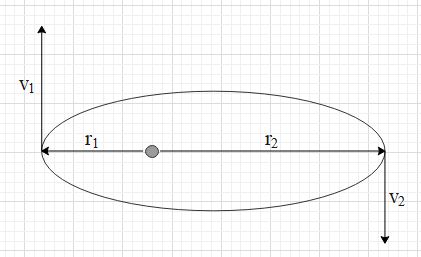
The ratio of KE of a planet at the point 1 and 2 is :

$\text{A}\text{. }{{\left( \dfrac{{{r}_{1}}}{{{r}_{2}}} \right)}^{2}}$
$\text{B}\text{. }{{\left( \dfrac{{{r}_{2}}}{{{r}_{1}}} \right)}^{2}}$
$\text{C}\text{. }\dfrac{{{r}_{1}}}{{{r}_{2}}}$
$\text{C}\text{. }\dfrac{{{r}_{2}}}{{{r}_{1}}}$

Answer
571.2k+ views
Hint: The angular momentum of the body about the sun at both the points will be the same. Use the formula for the angular momentum and equate the both. Find the ratio of the velocities of the body and with this find the ratio of the kinetic energies.
Formula used:
$K=\dfrac{1}{2}m{{v}^{2}}$
$L=mvr\sin \theta $
Complete step-by-step answer:
We know that the kinetic energy (K) of a body in motion is given as $K=\dfrac{1}{2}m{{v}^{2}}$, where m and v are the mass and speed of the object respectively.
Here the moving body is a planet. We know that a planet revolves in an elliptical orbit with the sun located at one of its foci.
The planet is attracted by the sun under the force of gravity. Since the direction of the force is always towards the sun, the net torque about the sun is zero. Therefore, the angular momentum of the planet is constant.
Therefore, the magnitudes of the angular momentums at the points 1 and 2 are equal.
The angular momentum of the body about a point is defined as $L=mvr\sin \theta $, where m is the mass of the body, r is the distance of the body from the point and $\theta $ is the angle between v and r.
In this case, at both the points the angle between the v and r is ${{90}^{\circ }}$. And we know that sin 90=1.
$\Rightarrow L=mvr$
$\Rightarrow {{L}_{1}}=m{{v}_{1}}{{r}_{1}}$
And
${{L}_{2}}=m{{v}_{2}}{{r}_{2}}$.
But ${{L}_{1}}={{L}_{2}}$
$\Rightarrow m{{v}_{1}}{{r}_{1}}=m{{v}_{2}}{{r}_{2}}$.
$\Rightarrow \dfrac{{{v}_{1}}}{{{v}_{2}}}=\dfrac{{{r}_{2}}}{{{r}_{1}}}$ …. (i)
The ratio of the kinetic energies at point 1 to point 2 is:
$\Rightarrow \dfrac{{{K}_{1}}}{{{K}_{2}}}=\dfrac{\dfrac{1}{2}mv_{1}^{2}}{\dfrac{1}{2}mv_{1}^{2}}=\dfrac{v_{1}^{2}}{v_{2}^{2}}={{\left( \dfrac{{{v}_{1}}}{{{v}_{2}}} \right)}^{2}}$.
Substitute the value of $\dfrac{{{v}_{1}}}{{{v}_{2}}}$ from equation (i).
$\Rightarrow \dfrac{{{K}_{1}}}{{{K}_{2}}}={{\left( \dfrac{{{r}_{2}}}{{{r}_{1}}} \right)}^{2}}=\dfrac{r_{2}^{2}}{r_{1}^{2}}$.
So, the correct answer is “Option B”.
Note: Since the angular momentum of a planet is constant, we can comment that as the distance of the planet from the sun increases, the speed of the planet decreases. As the planet approaches closer to the sun, its speed increases.
Therefore, the planet will have a maximum speed (maximum kinetic energy) at point 1 and a minimum speed (minimum kinetic energy) at point 2.
Formula used:
$K=\dfrac{1}{2}m{{v}^{2}}$
$L=mvr\sin \theta $
Complete step-by-step answer:
We know that the kinetic energy (K) of a body in motion is given as $K=\dfrac{1}{2}m{{v}^{2}}$, where m and v are the mass and speed of the object respectively.
Here the moving body is a planet. We know that a planet revolves in an elliptical orbit with the sun located at one of its foci.
The planet is attracted by the sun under the force of gravity. Since the direction of the force is always towards the sun, the net torque about the sun is zero. Therefore, the angular momentum of the planet is constant.
Therefore, the magnitudes of the angular momentums at the points 1 and 2 are equal.
The angular momentum of the body about a point is defined as $L=mvr\sin \theta $, where m is the mass of the body, r is the distance of the body from the point and $\theta $ is the angle between v and r.
In this case, at both the points the angle between the v and r is ${{90}^{\circ }}$. And we know that sin 90=1.
$\Rightarrow L=mvr$
$\Rightarrow {{L}_{1}}=m{{v}_{1}}{{r}_{1}}$
And
${{L}_{2}}=m{{v}_{2}}{{r}_{2}}$.
But ${{L}_{1}}={{L}_{2}}$
$\Rightarrow m{{v}_{1}}{{r}_{1}}=m{{v}_{2}}{{r}_{2}}$.
$\Rightarrow \dfrac{{{v}_{1}}}{{{v}_{2}}}=\dfrac{{{r}_{2}}}{{{r}_{1}}}$ …. (i)
The ratio of the kinetic energies at point 1 to point 2 is:
$\Rightarrow \dfrac{{{K}_{1}}}{{{K}_{2}}}=\dfrac{\dfrac{1}{2}mv_{1}^{2}}{\dfrac{1}{2}mv_{1}^{2}}=\dfrac{v_{1}^{2}}{v_{2}^{2}}={{\left( \dfrac{{{v}_{1}}}{{{v}_{2}}} \right)}^{2}}$.
Substitute the value of $\dfrac{{{v}_{1}}}{{{v}_{2}}}$ from equation (i).
$\Rightarrow \dfrac{{{K}_{1}}}{{{K}_{2}}}={{\left( \dfrac{{{r}_{2}}}{{{r}_{1}}} \right)}^{2}}=\dfrac{r_{2}^{2}}{r_{1}^{2}}$.
So, the correct answer is “Option B”.
Note: Since the angular momentum of a planet is constant, we can comment that as the distance of the planet from the sun increases, the speed of the planet decreases. As the planet approaches closer to the sun, its speed increases.
Therefore, the planet will have a maximum speed (maximum kinetic energy) at point 1 and a minimum speed (minimum kinetic energy) at point 2.
Recently Updated Pages
Why are manures considered better than fertilizers class 11 biology CBSE

Find the coordinates of the midpoint of the line segment class 11 maths CBSE

Distinguish between static friction limiting friction class 11 physics CBSE

The Chairman of the constituent Assembly was A Jawaharlal class 11 social science CBSE

The first National Commission on Labour NCL submitted class 11 social science CBSE

Number of all subshell of n + l 7 is A 4 B 5 C 6 D class 11 chemistry CBSE

Trending doubts
What is meant by exothermic and endothermic reactions class 11 chemistry CBSE

10 examples of friction in our daily life

One Metric ton is equal to kg A 10000 B 1000 C 100 class 11 physics CBSE

1 Quintal is equal to a 110 kg b 10 kg c 100kg d 1000 class 11 physics CBSE

Difference Between Prokaryotic Cells and Eukaryotic Cells

What are Quantum numbers Explain the quantum number class 11 chemistry CBSE




